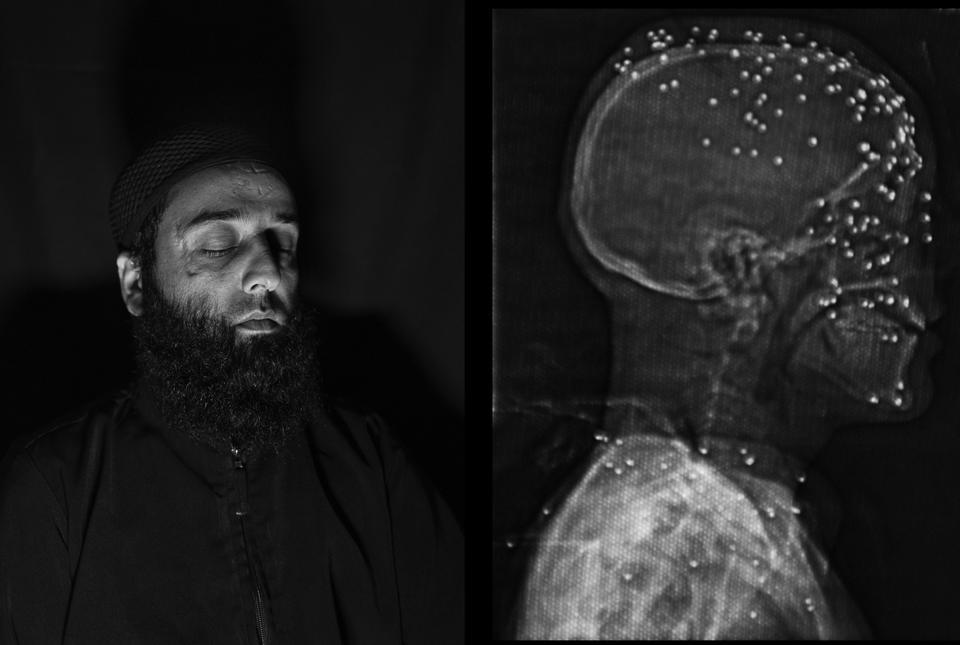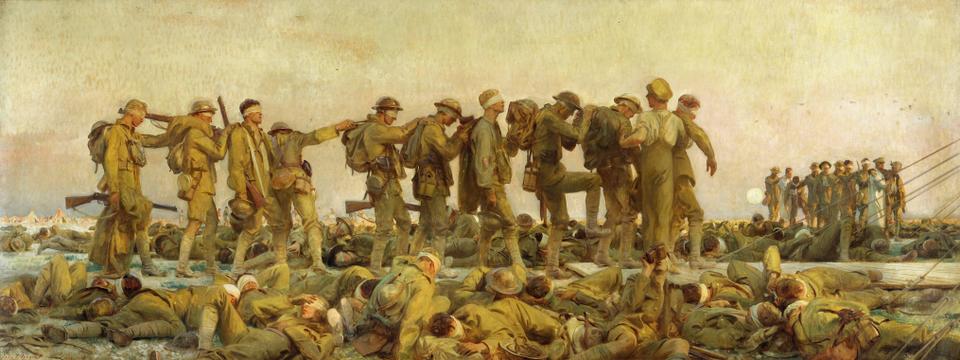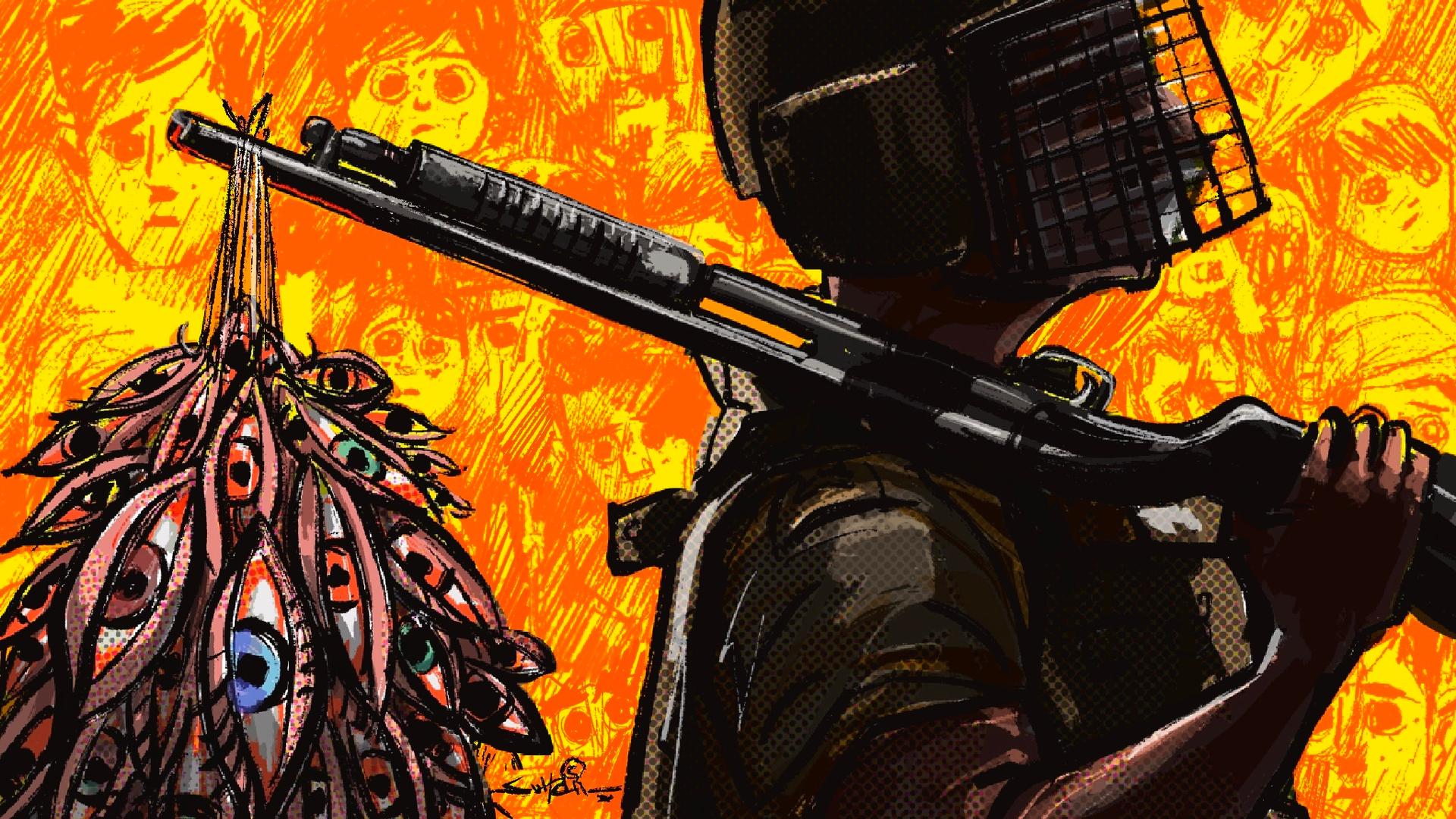The use of ‘pellet-guns’ in Kashmir is categorically a war crime.
On 28 August 2020, Indian forces in Srinagar opened fire with “pellet guns” on a peaceful religious procession. More than forty people were wounded while several were blinded. As usual, Pakistan protested vehemently. As usual, Indians responded on Twitter with triumphalism and aggression – if you don’t want to get shot, they said, don’t come out on the streets. And as usual, the world watched in silence.
It was not always so. India first started using pellet-firing shotguns against Kashmiris in 2010 but the matter only hit international prominence in 2016 when protests following the death of Burhan Wani resulted in thousands of injuries, the blinding of hundreds and the deaths of over 70 people.
The Guardian, for example, published a story asking if Kashmir represented “the world’s first mass blinding.” Even Indians were rocked by a viral series of pictures showing the distorted faces of celebrities.
The storm of international condemnation resulted in India scaling back the use of pellet-firing shotguns but not abandoning the weapons. In August 2019, when protests erupted against the revocation of Article 370, Kashmiris were again dispersed with shotguns. Subsequently, shotgun usage subsided but that was simply because there was an unprecedented months-long lockdown in Kashmir in which people were confined to their houses. But as recent events show, India has not given up on shotguns. They remain India’s weapon of choice to deal with Kashmiris.
One of the many tragedies of Kashmir is that it often gets subsumed into a larger narrative about the “unfinished business of Partition.” This narrative imposes a geostrategic lens on the issue and leads to a reductive analysis about whether Kashmir belongs to either India or Pakistan, a debate which India then further muddies by trying to paint all Kashmiri opposition as ‘Islamic terrorists’, a debate which the rest of the world has long since learned to tune out.

Kashmiris are not just symbols of injustice: they are real people living real lives in terrible pain. They also have rights under international law, rights which are being consistently violated. Irrespective of how the territorial issue of Kashmir is eventually resolved, there is a human aspect to Kashmir which needs to be confronted now. This is not just a dry legal dispute to be debated in textbooks and seminars: India’s ongoing use of shotguns is a war crime.
Indian sources – and by extension, many international sources – normally do not use the word “shotgun” to describe the weapons used by Indian forces in Kashmir. Instead, they use the term “pellet gun.” This is a misnomer. The term “pellet gun” is associated with the type of airguns used to shoot balloons at village fairs; that is, guns which fire individual pellets and must be reloaded after every shot.
However, the guns used by Indian forces bear no resemblance to such weapons. Instead, Indian forces use standard 12 gauge pump-action shotguns, each of which can be loaded with up to four shotgun shells.
Admittedly, each shotgun shell is in turn loaded with up to 600 pellets. But that, by itself, is no excuse to refer to a deadly weapon as if it was a child’s toy. As Orwell advised many years ago, it is generally better to use plain words. To quote a group of English parliamentarians, “[T]he phrase ‘shotgun’ may better convey the violence which these weapons embody. These shots can mutilate and blind and have had an impact on hundreds of individuals caught in the crossfire.”
The facts of the case
So far as international law is concerned, the position is very simple: there is no legal regime which permits a state to routinely disperse crowds of civilians by firing shotguns at them. This is true whether it is assumed that India has illegally occupied and annexed Kashmir (as per Pakistan), that Kashmir is “disputed territory” (as per the UN Security Council, the UNGA and the OIC); or whether one assumes that Kashmir is an integral part of India (as per the Government of India).
If we start with India’s contention that it exercises undisputed sovereignty over Kashmir, it follows that Kashmiris are entitled to the full range of human rights afforded to them under international law (including the right not to be shot at random with shotguns).
Of course, India may argue that (a) international law is only applicable to the extent enacted into domestic law; and (b) India’s independent judiciary has decided that the use of shotguns for crowd control does not violate Indian law. However, there are certain human rights obligations which cannot be ignored by any state, irrespective of domestic laws and domestic judges. Article 6(1) of the International Convention on Civil and Political Rights (ICCPR) is one such norm and states as follows:
“Every human being has the inherent right to life. This right shall be protected by law. No one shall be arbitrarily deprived of his life.”
The key word here is “arbitrary.” And in this context, it is important to examine the weapon itself which is being used.
The shotguns used by the Indian army are manufactured at the Ordnance factory in Ishapore. Till date, Indian authorities have refused to divulge information about them on national security grounds. However, reports suggest that the guns are crude copies of the American Mossberg 500 series which were originally used in World War 1 for close-quarter combat.

In Kashmir, Indian forces have been using No. 6 (300 pellets of 2.79mm each) and No. 9 (600 pellets of 2.30 mm each) cartridges. For such small pellets, the key issue is the distance from which they are fired. If they are shot at a closer range, the pellets do not have time to disperse and instead travel in a high-speed clump behaving almost like a handgun bullet. This makes them incredibly harmful and they can penetrate tissue and even bone, causing serious damage. However, if they are fired from a distance, the pellets disperse haphazardly.
According to the Omega Research Foundation (ORF), an independent UK-based organisation that monitors military equipment, “the spread pattern specified by the pellet manufacturer is so inaccurate that even when security forces use the weapon to target protesters’ legs, pellets are still likely to hit areas of the body above the waist.” According to a spokesman for the ORF, “This weapon should not be used at all. No modification could make its use compliant with international human rights law and standards.”
In simple terms, there is no safe or legal way to use a shotgun for crowd control. At close quarters, a shotgun is lethal. When used from a distance, a shotgun is entirely arbitrary and indiscriminate. Either way, the result is unjustifiable cruelty.
International human rights law on policing and the use of lethal weapons is enunciated most clearly in two documents approved by the UN General Assembly, the Code of Conduct for Law Enforcement Officials (1973) and the Basic Principles on the Use of Force and Firearms by Law Enforcement Officials (1990). Each of these is now regarded as declaratory of the customary law.
The content of these two documents amounts to basic common sense: that the use of force should be limited to the extent necessary, that it should not be disproportionate, that it should be backed by law and that there should be an effective means of accountability if force is used.
In relation to the use of deadly force, these principles require additional care and precision: intentional lethal force can thus only be used if there is an imminent danger of death or serious injury that cannot otherwise be averted. Finally, there is the principle of precaution: that all operations be “planned, prepared, and conducted so as to minimize, to the greatest extent possible, the recourse to lethal force.”

India’s use of shotguns for crowd control fails all of these tests. Shotguns are not just inherently indiscriminate weapons, but India’s usage of them is horrendously cruel. Human beings instinctively shudder when confronted with the prospect of being blinded. One reason why the world banned chemical weapons after World War I is because of the collective trauma of watching blinded soldiers shuffle past, each with their hand on the soldier in front.
No probable cause
More recently, an international convention banning the use of blinding laser weapons was promulgated in 1998 precisely because there is a unique revulsion attached to the deliberate blinding of humans.
More importantly, India regularly uses shotguns against crowds even when there is no imminent danger of death or serious injury to Indian forces. In the most recent instance, for example, the people who were fired upon were not even protesting: they were simply taking out a religious procession.
There is also no realistic possibility of accountability. Back in 2015, Amnesty International noted that over the previous 25 years, “not a single member of the security forces deployed in [Kashmir] has been tried for human rights violations in a civilian court.”
Finally, there has been no serious attempt by India to develop alternate means of crowd control. A committee was set up to examine such options as far back as 2016 but till date, shotguns remain the preferred option for Indian forces in Kashmir. And India’s insistence that it has no other option is absurd. There is no other country in the world besides India which uses shotguns for crowd control. And even within India, there is no other place besides Kashmir where shotguns are regularly and consistently used for crowd control.
When faced with such queries, Indian defenders retreat to different norms. Kashmir is not a normal civilian area, they argue. It is instead a warzone where Indian soldiers are confronted with an externally fomented Islamist insurgency. In short, they argue, India’s actions in Kashmir need to be judged using the laws of war, not the laws of peace.
But the problem for these defenders is that Indian actions in Kashmir fail even the laws of war.
The precise relationship between international human rights law and the laws of armed conflict is heavily debated. However, there is a broad consensus that the laws of war represent a specialised set of rules which take precedence over international human rights law, but only to the extent there is an actual conflict in terms of the applicability of the two sets of laws. Thus, the mere fact that there is an armed conflict does not by itself negate the applicability of international human rights law. In fact, the ICJ has specifically held that “the right not to arbitrarily be deprived of one’s life [under Art. 6 ICCPR] applies also in hostilities.”
In the case of Kashmir, there is no actual conflict between the two sets of laws. This is because India is not using shotguns to fight militants. Instead, it is using shotguns as a crowd control measure against civilians. The laws of war do not regulate the conduct of normal policing measures or the manner in which local administrations can control otherwise peaceful protests.
In fact, to the extent a state is called upon during times of war to perform normal policing functions with respect to a civilian population, it must act in accordance with normal policing procedures. And as already noted, the established norms of policing do not permit states to disperse crowds by firing shotguns at them.
One of the most fundamental principles of the laws of war is the principle of distinction, i.e., that fighting states must always distinguish between combatants and civilians. Even if it is assumed that Kashmir is the site of armed conflict, that only authorises the Indian military to use deadly force against combatants, not civilians. Furthermore, the law of armed conflict recognises a very bright and clear line between the two categories: civilians cannot be attacked in the same manner as combatants “unless and for such time as they take a direct part in hostilities.”
Participating in a protest against Indian occupation does not constitute taking “a direct part in hostilities.” That standard is only met when a specific act directly targets military operations or military capacity of a party to an armed conflict and is specifically designed to cause a certain, non-minimal level of harm to that party. Shouting slogans at a march does not qualify as taking a “direct part in hostilities.” Even throwing stones at soldiers does not qualify as taking a “direct part in hostilities.”
Collective punishment
Another, equally fundamental principle of the law of armed conflict is the principle of proportionality. In simple words, this principle prohibits attacks against a military objective if the incidental loss of civilian life would be “excessive in relation to the concrete and direct military advantage anticipated.”
Even if some people participating in demonstrations are also actively helping Kashmiri freedom fighters, the use of shotguns is still illegal. Indian forces have no way of knowing which protestors – if any – are also active in the Kashmiri resistance. It cannot, therefore, use weapons which kill, blind and maim at random.
It is this arbitrary aspect of shotgun usage which is the biggest issue. When an Indian soldier fires a shotgun at a crowd of Kashmiris, the current SOPs stipulate that he should fire from a distance of at least 40-50 metres. At that distance, it is impossible to aim a shotgun with any degree of accuracy: one is only aiming at a mass of people, knowing full well that a certain number of them are likely to die, that a slightly greater number are likely to be blinded, and that an even greater number are likely to be injured. The usage of shotguns for crowd control is thus no different from rounding up protestors and blinding (or killing) an arbitrary number of them.

Collective punishment has a long and inglorious history. The word “decimate” comes from the Roman Army’s tradition of killing every tenth member of a mutinous cohort. Conquering armies in Europe were traditionally allowed three days of pillage after subduing a city while the Mongols preferred to build towers from the skulls of those foolish enough to resist.
In more recent times, the Nazis during World War II regularly massacred entire villages in response to the killing of a single German (see, for example, the 1942 killing of 340 Czechs in response to the assassination of Reinhard Heydrich). It is precisely for this reason that collective punishment is clearly prohibited by both the Third and the Fourth Geneva Conventions of 1949 as well as the Hague Regulations of 1899 (all of which have been signed and accepted by India).
In theory, India could argue that Kashmir is not an “armed conflict” of the type to which the laws of war apply. However, that debate misses the point: what India has deliberately and consciously adopted as a state policy in Kashmir is so cruel and so inhumane that it would constitute a war crime even if that type of armed conflict existed.
Furthermore, international human rights law and the laws of armed conflict do not exist in separate silos. As noted by the International Criminal Tribunal for Yugoslavia in the Tadic matter, “elementary considerations of humanity and common sense” mandated that “[w]hat is inhumane, and consequently proscribed, in international wars, cannot but be inhumane and inadmissible in civil strife.”
The Security Council has chosen to remain quiet for many years on Kashmir. But the fact that Kashmir is disputed has nothing to do with the human rights of Kashmiris. Their human rights are undisputed. And it is time that the international community stopped turning a blind eye to India’s violation of those rights.
Cover illustrations by Suhail Naqshbandi
Author: Feisal Naqvi
Feisal Naqvi is a lawyer based in Lahore, Pakistan.
Source










Discussion about this post